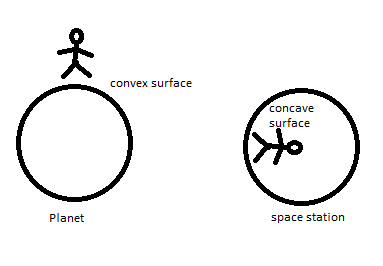I read this in a comment to an answer in physics.stackexchange.com. The comment was
An easier method might be to just place a straight, rigid beam on the floor. If you find the floor is concave, you're probably on a space station. The technique you describe would only work on a relatively small station (which would therefore require a rather large angular velocity to achieve 9.8m/s centrifugal acceleration) where you would probably notice the concavity of the floor just by looking at it. This phenomenon would also be observed on Earth, but the angular velocity of the planet is sufficiently small that atmospheric drag tends to overshadow its affect on ballistic objects
The discussion was about distinguishing between real gravity and rotating space station. My question is what does the commentator mean by concavity of the floor?
Note: Since I have only a few reputation, I cannot comment on that answer to ask the commenter to explain it.

